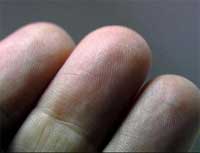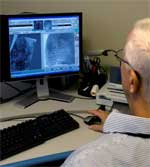The KBI Latent Print Section conducts work pertaining to the examination of latent prints, footwear and tire tracks on evidence submitted to the KBI Forensic Laboratory. Scientists analyze and compare these items in all types of criminal cases from misdemeanors to felonies.
Handling and Submission of Latent Print Evidence

Latent prints are fragile and studies have shown that handling and packaging evidence can destroy latent prints. Care should be given to this sensitive evidence and the proper steps taken so prints are not destroyed. When handling an item of evidence, always wear gloves. Also try to handle the item in places where the item is not usually handled - i.e. the inside of a jar. Packaging material may protect the item from damage, but it also can obliterate latent prints. If possible, evidence should be secured in the package to limit the movement inside the package. If an item has been processed by the contributing agency, please note this on the evidence custody receipt (ECR) when submitting.
Powder processing of evidence is often done at the scene and latent lifts are collected from the evidence. Be aware that the processors print can sometimes be left on the tape lift. Please cross out these contributor prints before submission to the KBI. The lifts taken from the scene do not need to be packaged separate from one another and can be packaged in sealed envelopes or plastic bags, just submit them as one item with the total number of lifts.
Known fingerprints of suspects, victims or other prints for elimination should be submitted for comparison to any prints found. Photocopies of known cards can be used; however, the original should be submitted if at all possible. These known cards should be submitted as a separate item on the ECR. If known cards are not submitted, please list any persons involved (example victims, elimination, others) along with other identifying information such as a DOB and/or SSN.
After comparison to the known prints submitted, any unidentified latent prints will automatically be entered into the Automated Fingerprint Identification System (AFIS).
Automated Fingerprint Identification System (AFIS)

The KBI Automated Fingerprint Identification System (AFIS) contains more than one million ten-print and palm print cards received from law enforcement agencies throughout the state. They are primarily used to determine whether a prior arrest record exists and then for maintaining a criminal arrest record history for each individual.
This system also offers significant latent print searching capabilities such as:
- Searches of latent fingerprints and palm prints against the known cards when no suspects have been developed.
- Automatic searches of new arrest and civil records against the unsolved latent fingerprint and palm print repository.
- Searches of latent fingerprints against the NGI Criminal Fingerprint Database.
- Connection to Missouri AFIS for latent print searches.
Since the installation of the KBI AFIS in 1990, more than 5000 latent prints have been identified to new suspects.
Footwear and Tire Track Evidence
Casts, photographs, gel, rubber, tape and electrostatic dust lifts are examined in the Latent Print Section for questioned footwear and tire track impressions.
Cast evidence:
- Dental stone is usually the best option available for creating a cast of a footwear or tire track impression.
Photographs as evidence:
- Optimal photographs contain a proper scale, are taken parallel to the impression and include a crime scene marker or other means to identify the different impression.
- When submitting photographs of the entire crime scene please indicate the specific images numbers that are to be examined for footwear or tire track impressions.
- Please note that by following the tips above it will include a proper scale.
Known footwear and tire evidence:
- Known footwear should be packaged in cardboard or paper, not plastic.
- Known tires are accepted at the KBI as evidence as long as they are packaged and sealed properly.
- Known test impressions of tires are accepted at the KBI as evidence as long as they are packaged and sealed properly.
• When taking known tire test impression make sure to record the full circumference of each tire.
• On each test impression provide the following information:
- Location on the vehicle, tire brand, model, size and DOT number and type of vehicle. - Known test impressions of footwear are accepted at the KBI as evidence if the known footwear cannot be submitted.
• When taking known footwear make sure to record the entire outsole.
• On each test impression when available provide the following information:
- Brand of footwear, style, size of shoe, right or left and any other manufacture information (information from the tag). - Sufficient questioned impressions can be searched in a footwear and tire track database
- Coming soon: A footwear and tire track searchable database.
Training
The section also provides training in all aspects of latent print, footwear and tire track collection and processing to local and state law enforcement personnel. If your agency is interested in having training provided by the KBI Latent Print Section please call 785-296-1137 for more information. In addition, we conduct research to evaluate new technologies, procedures, and equipment.
Contact Information
If you have any questions on a specific case or if we can assist you in any way, please do not hesitate to contact the KBI Latent Print Sections in the following statewide laboratories.
KBI Topeka Laboratory
785-296-1137
KBI Great Bend Laboratory
620-792-4353
KBI Pittsburg Laboratory
620-230-5814
For more on information relating to latent prints, footwear or tire tracks see these links:
International Association for Identification (IAI)
Kansas Division of the International Association for Identification (KDIAI)
Scientific Working Group on Friction Ridge Analysis, Study and Technology (SWGFAST)
Scientific Working Group for Shoeprint and Tire Tread Evidence (SWGTREAD)







